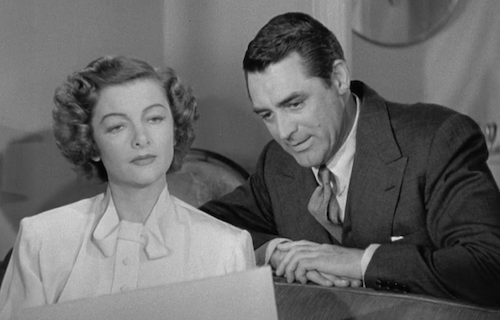
**Some spoilers, but then again, this is a comedy.***
I’ve been remiss in my blogging lately, due to my second move in a year. The last apartment resounded with construction noises next door, loud and consistent and close enough to drive me to repacking. So again I’ve been drowning in UHaul boxes, unsticking packing tape from my shoes, figuring out just how little I can get away with repurchasing, and wondering how few calls I can make changing my rental address.
Films about renting typically revolve around roommates, so to find characters to commiserate with (and limit the number of real-life sufferers from my complaints), I’ve turned to stories about much bigger headaches than mine: Walter’s (Tom Hanks) and Anna’s (Shelley Long) alternately endearing and hilarious breakdowns after they buy the lemon in The Money PIt (1986). The lovable Blandings (Cary Grant and Myrna Loy) as they sink their cash into first destroying one house, then building another in its place in Mr. Blandings Builds His Dream House (1948).
I like both films so much, but today, I’m going to discuss the original: Tired of fighting over mirrors and closets and other ills of close apartment living with a spouse and two kids, Jim Blandings (Grant) convinces his wife, Muriel (Loy), to move to Connecticut with him, to a big shambling old relic that’s just about to crumble. Comedy ensues, especially when Jim’s jealousy over his lawyer (who once dated Muriel) surfaces while he’s trying to tackle falling parts and failed wells and bad bathroom locks. Of course, Jim and Muriel soon find the costs building up and the issues with first the old, then the replacement house mounting. So much to love about this film. Let’s begin with:
The Realistic Depiction of Marriage
The Blandings frequently squabble about everyday annoyances, but my favorite moments are those that display patience with one another’s faults, as when Jim refuses to believe Muriel knows the directions to their new place, and she patiently waits out his acknowledgment of her correctness through multiple wrong turns, a quiet smile and gaze toward the sky revealing her amusement at how it’s all going to turn out:
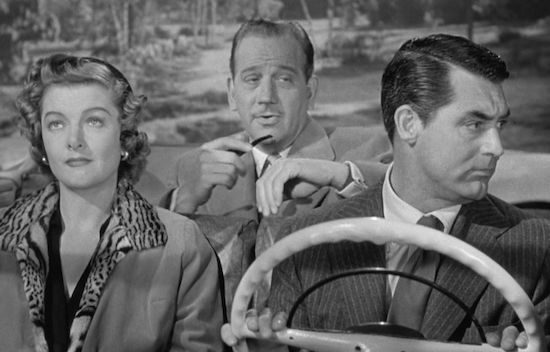
Unlike most films that depict a husband jealous of his wife’s affections, Mr. Blandings Builds His Dream House does a subtle job conveying quietly brewing suspicions. While Jim’s jealous of his lawyer, Bill (Melyvn Douglas), throughout the film, the sentiment is understated, only boiling over when his stress level does, and therefore never failing to feel authentic. Weaker comedies play such weaknesses broadly instead; the sophisticated version of jealousy here matches that in so many more marriages, and therefore is funnier.
The (Meta) Supporting Actor Casting
The actor playing Grant’s object of jealousy is Melvyn Douglas, often viewed as a second-rate replacement for Grant in romantic comedies. He’s debonair and can be charming, but he’s no Grant.
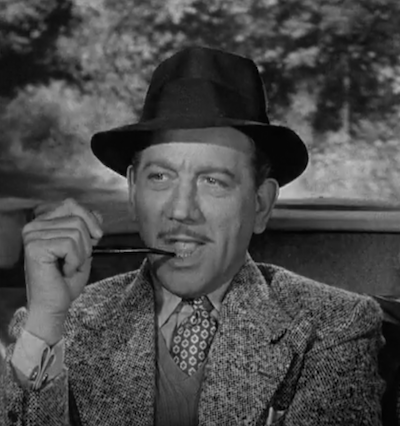
But Douglas is always better as a supporting actor than as a hero, and does great work as the foil in this film. And some may say he did get the last laugh: he, unlike Grant, his romantic lead rival, would win not one, but two Oscars later in his career.
The Inspired Acting (and Chemistry) of Grant & Loy
Every frame of the film conveys the joy of home ownership and the stress of building and moving so well, thanks to the stellar performances. Honestly, as mobile as these two stars’ faces are, this film could have easily been a silent. Just take these shots of Grant in smirk and self-embarrassment mode, respectively.
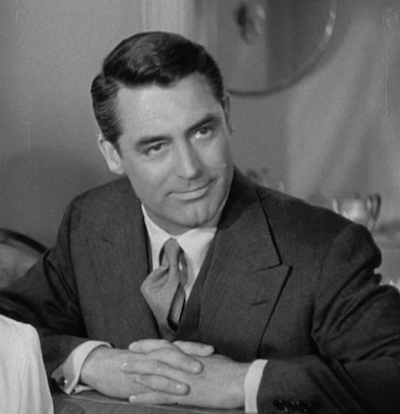

Or Loy’s face as she expresses love, mockery, and shocked anger in turn:
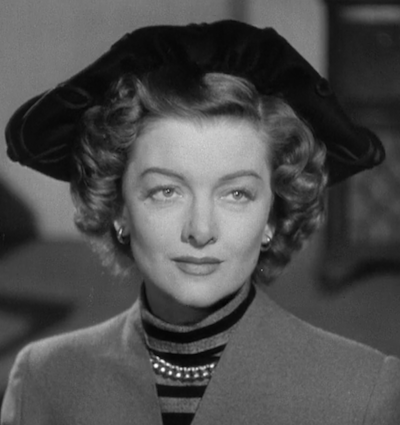
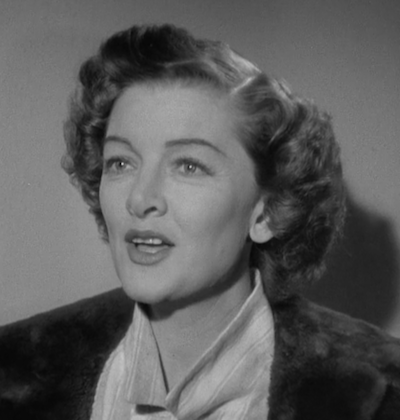
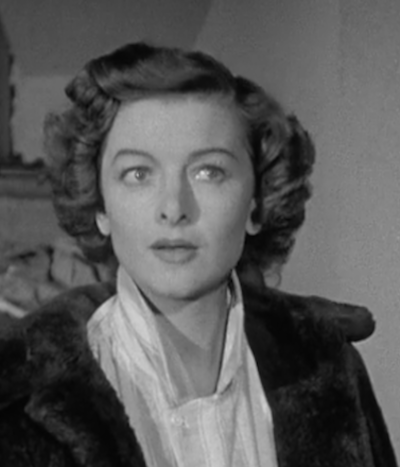
The actors’ best scene is after Jim expresses jealousy over his wife’s past relationship with Bill. His expressions–one part suspicion, one part hope, one part shame–are so nuanced and real.
When he pouts, asking why she married him, she fires back in a brilliantly worded (thanks to the script) rebuttal:
“I’m beginning to wonder….” she says. “Maybe I knew you were going to bring me out to this $38,000 icebox, with a dried-up trout stream and no windows…Or maybe I just happened to fall in love with you, but for heaven’s sake, don’t ask me why.”
The scene is pitch-perfect Loy. Only she could be so angry and endearing simultaneously.
Quibbles
Luckily, the voiceover narration, which is occasionally grating, is in short supply. It is used to great effect in the opening, which depicts decidedly unidyllic city living.
I’m not a big fan of the scene in the film most love, when Muriel gives a comic level of detail about the wall colors she wants, and the painters reduce her requirements to red, yellow, etc. as soon as she turns her back. It’s just so sexist, so “oh that silly woman” in its approach. In contrast, her sink mistake, which is also depicted as foolhardy, is treated as if it’s on the same level as Jim’s errors. But Loy is fabulous in the painting scene, sure she’ll be taken seriously and oblivious to the painters’ condescension.
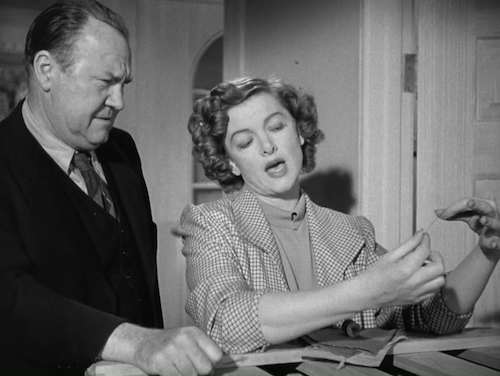
While Jim’s work stress during the building is a little undercooked plotwise, there are comic gems, as when Grant’s creative process is depicted:
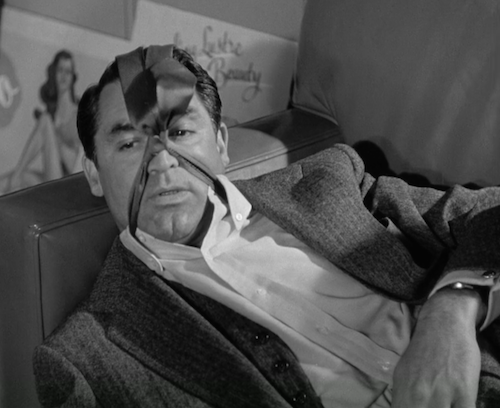
But the joy of these brief work scenes is undermined by the portrayal of Gussy (Louise Beavers), the housekeeper, who will later be featured, Aunt Jemima style, in Jim’s ad about some Spam-like product. He does offer her a $10 raise for coming up with the ad idea that saves his job, and she doesn’t come across as stereotypically as some black actresses at the time did (Gussy does, after all, originate the ad). But it sure would be cool to see more for Beavers (and Gussy), especially given how progressive Loy was, and given Beavers’s earlier star-making turn in Imitation of Life.
Of course, the film’s legacy, despite these weaknesses, comes down to….
Its Comic Writing & Pacing
Wry humor sparkles throughout, especially when Grant has a breakdown near the film’s close. When the couple is first purchasing the old house, others observe that it’s junk, as when Bill looks at the Blandings and observes, “It’s a good thing there are two of you. One to love it, and one to hold it up,” or when Jim asks for a structural engineer’s analysis of the house, and the man succinctly replies, “Tear it down,” a caution two other engineers repeat, word for word.
The film is so efficiently edited, so quickly paced, that there’s little time to dwell on one change before another is brewing, accurately echoing the hectic pace of changing a home.
I love that so much goes wrong in the film that the move itself is briefly canvassed in order to get on to the bigger problems. Jim’s jealousy is also neatly addressed, without sidelining the story of the house. Unlike its indirect remake, Money Pit, the film doesn’t address the number of people swindling or lying to the Blandings (besides the house cost) so much, instead relying on ignorant decisions and accidents of nature. I love when the Blandings, with no knowledge of architecture, settle down to each add all their own cool features to the blueprints, as the architect looks on in dismay:
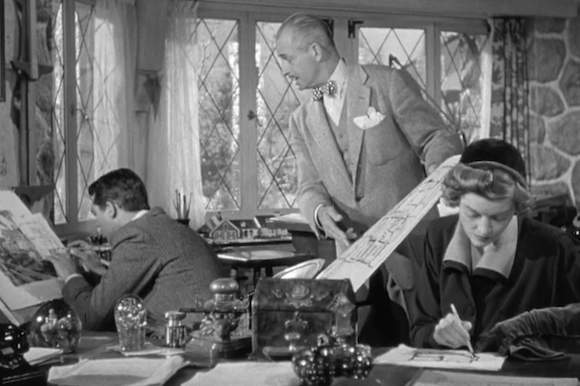
And yet, as unrealistic and financially reckless as the two prove to be, you also see why it’s worth it, to find the home they want, to set aside the troubles it took to get there. And in the moments they enjoy it, you’re proud of this idealistic couple. Proud that in spite of all their foolishness, they stubbornly hold on, and get what they wanted. It may not always be true, or even often be true, but sometimes, it’s just worth it to try for that dream home.
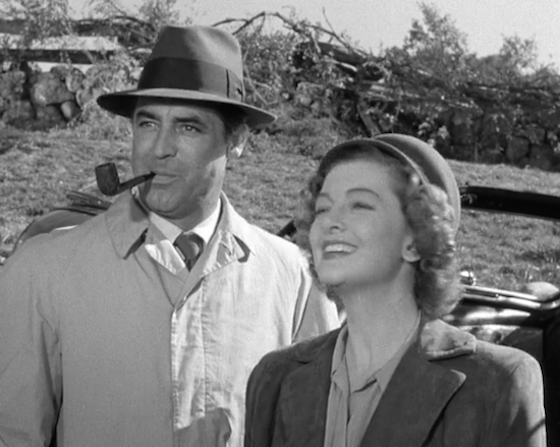

Reginald Denny! I forgot Reginald Denny was in this.
Pardon my outburst, but it has been a long time since I sampled the delights of Mr. Blandings Builds His Dream House. I’ve been watching too much HGTV. Thanks for a much needed reminder, and good luck on the latest move.
Thank you! Yes, he’s quite good in it. I haven’t seen enough of his work. I just rewatched it after many years; it doesn’t matter how many times you see it–always good.
I adore this movie. Like you said, there’s much to love about it, including the fab script and the terrific performances.
I liked what you said about the editing and how the movie moves quite quickly. There’s no dwelling on any one things – there’s too many other things waiting to go wrong!
Hope all is going well with your move, which is a dreadful chore indeed.
Yes, it’s really amazing pacing–not screwball quickness because there needs to be sufficient time to take in their pain and stress, but fast enough that you get the chaos. Thank you! I’m almost done with the boxes, so just a few more things to do.
Yay-thank you for the carefully chosen photos and well-written prose about this gem of a comedy! I saw it many years ago and then saw “The Money Pit” within a y at or two after that. While I enjoyed “The Money Pit”, I preferred “Mr. Blandings” due to my penchant for Cary Grant and Myrna Loy. I also love Louise Beavers—it’s nice to see her working with Loy again as they were fun to watch together 7 years earlier in “Shadow of the Thin Man”!
Good luck on your move-hope you give yourself enough time to take breaks. I moved from a two bedroom townhouse last year, and packed over 100 boxes! I’m still not over it! LOL!
Thank you! Yes, I love those two together so much. Hard to get over the fact that there are multiple films with Grant & Loy, isn’t it?:) We’re so lucky. I have a soft spot for the Money Pit, mainly because Hanks’s laughing breakdown is one of my favorite moments in all of film. And Bosco and Stapleton are hilarious in it. But it could use some editing, unlike Blandings, which is so economically written. And Loy is so much more fun than Long (though it is one of her best of non-Cheers work). Thank you for the good wishes on the move. I should have counted the boxes; you are brave to have done it!
This is a fine, interesting article. I enjoyed reading it, and I look forward to reading more of your articles in the future.
By the way, I would like to invite you to join my blogathon, “The Great Breening Blogathon:” https://pureentertainmentpreservationsociety.wordpress.com/2017/09/07/extra-the-great-breening-blogathon/. It is celebrating the life and work of Joseph Breen, the enforcer of the Motion Picture Production Code between 1934 and 1954. As we honor his birthday, which is on October 14, we will be discussing and analyzing the Code era, breening films from other eras, and writing about our own ideas for classic movies. One doesn’t have to agree with the Code and Mr. Breen to enjoy that! I hope you will do me the honor of joining. We could really use your talent!
Yours Hopefully,
Tiffany Brannan
Thanks! I’d like to join. I’ll let you know. October is my busiest month in the fall, but I should know by the start of next week if I can. Very fun event! I especially like the be a filmmaker option:)
Dear Leah,
Thank you for replying. I do hope you’ll be able to participate, but I know that October is going to be a very busy month for a lot of people. I’m glad you like my topic. I look forward to hearing from you!
Yours Hopefully,
Tiffany Brannan
We agree on best scene in a great comedy – Perfect Wife Myrna going off on Cary. She even heckles the dimple in his chin! That Cary could be the harried every man while also saving Ingrid Bergman from Nazis is just more testament to his greatness. And I love how blithely oblivious Muriel is through much of the movie – quite unlike most of Myrna’s roles!
He’s so brilliant. And you’re right, she is oblivious, though there is some of that sharp wit we’re used to:). Both she and he are so oblivious about any practical concerns that it’s hilarious to watch. Two of my favorite actors.